![]()
![]()
![]()
Use LEFT and RIGHT arrow keys to navigate between flashcards;
Use UP and DOWN arrow keys to flip the card;
H to show hint;
A reads text to speech;
41 Cards in this Set
- Front
- Back
- 3rd side (hint)
|
What is magnetite? |
Magnetite is a naturally occuring iron oxide mineral. It is a natural magnet ththat attracts certain materials like cobalt, nickel and steel. |
|
|
|
What are magnetic or ferromagnetic materials? |
Magnetic or ferromagnetic materials are materials that are attracted by magnets. |
|
|
|
Give 3 examples of magnetic or ferromagnetic materials. |
examples of magnetic or ferromagnetic materials: 1) cobalt 2) nickel 3) steel |
|
|
|
What is a permanent magnet? |
A material that retains its magnetism for a long time is called a permanent magnet. |
|
|
|
With what materials are permanent magnets usually made up of? (3) |
Permanent magnets are usually made up of: 1) steel (an alloy of iron iron and carbon) 2) alloys like alnico (aluminium, nickel and cobalt) 3) alcomax (iron, nickel, copper, cobalt, aluminium) |
|
|
|
What is the permanent magnet, ceramic magnet made up of? |
Ceramic magnet, a permanent magnet is made from ferrites-iron oxide compounds that contain other elements like boron, barium or nickel. |
|
|
|
What are the properties of magnets like ceramic magnet? |
Magnets like the ceramic magnet are often hard and brittle. |
|
|
|
What element are the strongest permanent magnet made up of? |
Magnets made from the rare element neodymium are among the strongest permanent magnets. |
|
|
|
Where are Neodymium magnets used? (3) |
Neodymium magnets are used in: 1) earphones 2) loudspeakers 3) hard disk drives |
|
|
|
State the 4 properties of magnets. |
Properties of magnets; 1) attract magnetic materials. 2) magnets have magnetic poles. 3) When we suspend a bar magnet freely, it will come to rest in the North-South direction. north-seeking pole (north pole or N pole) The end of the magnet that points to the northern end of the Earth is called the north-seeking pole (north pole or N pole) The end of the magnet that points to the southern end of the Earth is called the south-seeking pole (south pole or S pole) .4) Law of magnetism: Like poles repel, unlike poles attract. The end of the magnet that points to the southern end of the Earth is called the south-seeking pole (south pole or S pole) . 4) Law of magnetism: Like poles repel, unlike poles attract. , unlike poles attract. |
|
|
|
State the use of magnets due to the rest in the North-South direction when suspended freely. |
Magnets are used in compasses for navigation purposes due to the rest in the North-South direction when suspended freely. |
|
|
|
How is a magnet identified? |
If we move one end of the object towards the N pole of a suspended bar magnet, and repulsion occurs, we can conclude that the object is a magnet. |
|
|
|
Why when attraction occurs, we cannot conclude that the object is a magnet? |
When attraction occurs, we cannot conclude that the object is a magnet because the object may either be a magnetic material (not a magnet) that is attracted by the suspended magnet, or a magnet itself with the opposing pole on the approaching end (To be certain, we have to test the other end with the N pole to see if repulsion occurs) . |
|
|
|
What is the only test to confirm that an object is a magnet? |
Repulsion is the only test to confirm that an object is a magnet. |
|
|
|
What is magnetic induction? |
Magnetic induction is the process where ferromagnetic materials such as iron become magnetised when they are near or in contact with a permanent magnet. |
|
|
|
Describe how magnetic induction can occur without any contact with the magnet. |
A permanent magnet is brought near (but does not touch) an iron bar. The iron bar becomes an induced magnet. The N pole of the permanent magnet induces an S pole in the nearer end of the iron bar, while the further end of the iron bar becomes an N pole. |
|
|
|
State 2 ways of making magnets. |
Ways of making magnets : 1) Stroking method ; 2) Electrical method using a direct current. |
|
|
|
Define the stroking method to make a magnet. |
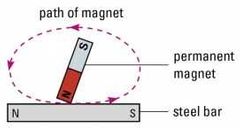
Stroking method: An unmagnetised steel bar is stroked several times with the same pole (e.g N pole) of a permanent magnet from one end to the other end in one direction. The stroking magnet is lifted sufficiently high above the steel bar between successive strokes. The steel bar will become a permanent magnet due to magnetic induction. The pole produced at the end of the steel bar where the strokes finish is opposite to the stroking pole used. |
|
|
|
Describe the electrical method by using a direct current to make a magnet. |
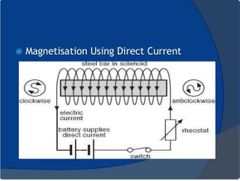
Electrical method by using a direct current ; The steel bar to be magnetised is placed in a solenoid (a cylindrical coil of insulated copper) The solenoid used should have several hundred turns of insulated copper wire. When a large direct current (d.c) is passed through the solenoid, the unmagnetised steel bar will become magnetised after a while. This is because when an electric current flows through the solenoid, it produces a strong magnetic field which magnetises the steel bar. |
|
|
|
What is a solenoid? |
A solenoid is a cylindrical coil of insulated copper wires. |
|
|
|
State the method where the poles of the magnet can be determined. |
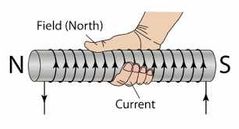
The poles of the magnet can be determined by the right-hand grip rule. |
|
|
|
State the 3 ways to demagnetise magnets. |
Ways of demagnetising magnets; 1) Heating 2) Hammering 3) Electrical method using an alternating current. |
|
|
|
How can heating be used to demagnetise magnets? |
If we heat a magnet strongly with a Bunsen flame, the magnet will lose its magnetism very quickly. |
|
|
|
How can hammering be used to demagnetise magnets? |
Hammering alters the alignment of the magnetic domains, causing the magnet to lose its magnetism. |
|
|
|
What is an alternating current? |
An alternating current is an electric current which varies its direction many times per second. |
|
|
|
What is a magnetic field? |
A magnetic field is a region in which a magnetic object, placed within the influence of the field, experiences a magnetic force. |
|
|
|
Describe how we can find the pattern of the magnetic field around a bar magnet by iron filings. |
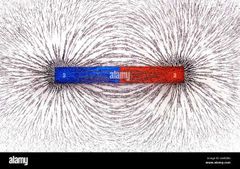
To reveal the pattern of the magnetic field around a bar magnet, we can place it on a piece of paper and sprinkle iron filings lightly around it, while tapping the paper gently. |
|
|
|
Describe the experiment to find the direction of the magnetic field lines with a plotting compass. |
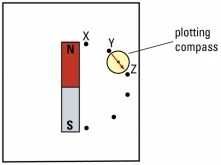
Objective: to plot magnetic field lines with a compass Apparatus: bar magnet, plotting compass, plain paper, pencil Procedure: 1. Place the bar magnet at the centre of the paper so that its N pole faces North and its S pole faces South. 2. Starting near one pole of the magnet, the positions of the ends, S and N, of the compass needle are marked by pencil dots X and Y respectively. The compass is then moved so that S end is at Y and the new position of the N end is marked with a third dot Z. 3. Repeat the process of marking the dots. Join the dots and this will give the plot of the magnetic field. Precautions: 1. Check that the plotting compass is in good working order. 2. Ensure that there is no strong magnetic field (other than the Earth's magnetic field) near the plotting compass. |
|
|
|
State the 3 principles that are applied when drawing magnetic field lines. |
Principles that are applied when drawing magnetic field lines; 1) Magnetic field lines are directed outward from the N pole and towards the S pole. 2) Magnetic field lines do not cross or intersect one another. 3) To represent strong magnetic fields , the fields line are drawn closer together. Field lines drawn further apart represents a weak magnetic field. |
|
|
|
Draw the magnetic field lines between an N pole and an S pole. |
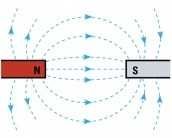
|
|
|
|
Draw the magnetic field lines between two N poles. |
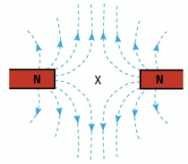
|
|
|
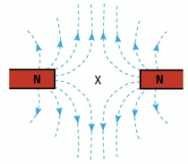
What is X called and why? |
X is called a neutral point because the fields from both magnets cancel out each other. |
|
|
|
What is magnetic shielding? |
Magnetic shielding prevents surrounding magnetic fields from reaching sensitive areas of a piece of equipment whose operation may be affected by the fields. |
|
|
|
Give 2 examples of materials that can be used for magnetic shielding. |
Thin sheets of soft magnetic materials (e.g iron and MuMetal) can be used for magnetic shielding. |
|
|
|
Describe an experiment to investigate the magnetic properties of iron and steel. |
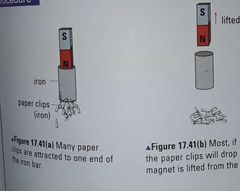
Experiment to investigate the magnetic properties of iron and steel:
Apparatus ; Bar magnet, iron and steel bars of equal dimensions - 20 cm in length, iron paper clips.
Procedure:
1) Let the N pole of the bar magnet attract one end of the iron bar. The other end of the iron bar is dipped into a tray of paper clips.
Record the maximum number of paper clips that are attracted to the iron bar.
2) Pull the magnet away from the iron bar. Observe what happens and record the number of paper clips still attracted to the iron bar.
3) Now repeat step 1 using the steel bar in place of the iron bar. Record the maximum number of paper clips attracted to the steel bar.
4) Pull the magnet away from the steel bar. Note and record the number of paper clips still attracted to the steel bar. (Picture in hint).
Observation; Iron is a stronger induced magnet and was thus able to pick up more paper clips. Iron, however does not retain its magnetism.
Steel is a weaker induced magnet and was thus able to pick up fewer paper clips. Steel, however retain its magnetism as the paper clips were still attracted to the steel bar even though the magnet was removed. |
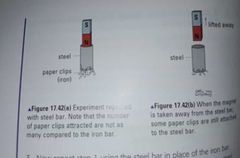
|
|
|
What are soft magnetic materials? |
Soft magnetic materials are magnetic materials such as iron which are easily magnetised but do not retain their magnetism. |
|
|
|
What are hard magnetic materials? |
Hard magnetic materials are magnetic materials such as steel, which are harder to magnetise but retain their magnetism. |
|
|
|
What are hard magnetic materials used for? |
Hard magnetic materials are used to make permanent magnets. |
|
|
|
What are soft magnetic materials such as iron used for?(2) |
Soft magnetic materials such as iron are used as 1) temporary magnets in electromagnets in the cores of transformers and in the cores of transformers and2) in magnetic shielding. 2) in magnetic shielding. |
|
|
|
Describe 4 uses of permanent magnets |
A moving-coil ammeter is a device used to measure current. The ammeter consists of a coil suspended in the magnetic field of a permanent magnet. When a current flows into and out of a coil, a turning effect is produced on the coil. A pointer attached to the coil will then move to show a value on the scale proportional to the size of the current. 2) Magnetic door catch 1) Moving- coil ammeter A moving-coil ammeter is a device used to measure current. The ammeter consists of a coil suspended in the magnetic field of a permanent magnet. When a current flows into and out of a coil, a turning effect is produced on the coil. A pointer attached to the coil will then move to show a value on the scale proportional to the size of the current. 2) Magnetic door catch Magnetic strips are fitted to the doors of freezers and refrigerators to keep the doors closed. 3) Peranent magnets are essential in the operation of numerous electrical machines such as d.c. motors and a.c. generators4) Permanent magnets (usually neodymium magnets ) are used in moving-coil loudspeakers. At the core of the loudspeaker, there is a very strong permanent magnet. Magnetic strips are fitted to the doors of freezers and refrigerators to keep the doors closed. 3) Peranent magnets are essential in the operation of numerous electrical machines such as d.c. motors and a.c. generators 4) Permanent magnets (usually neodymium magnets ) are used in moving-coil loudspeakers. At the core of the loudspeaker, there is a very strong permanent magnet. |
|
|
|
Describe how electrical method using an alternating current demagnetise magnets. |
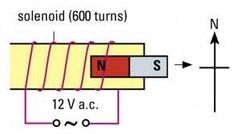
Place a magnet inside a solenoid connected to an alternating current (a.c.) supply. The magnet is then slowly withdrawn in the East-West direction with the alternating current still flowing in the solenoid. |
|

